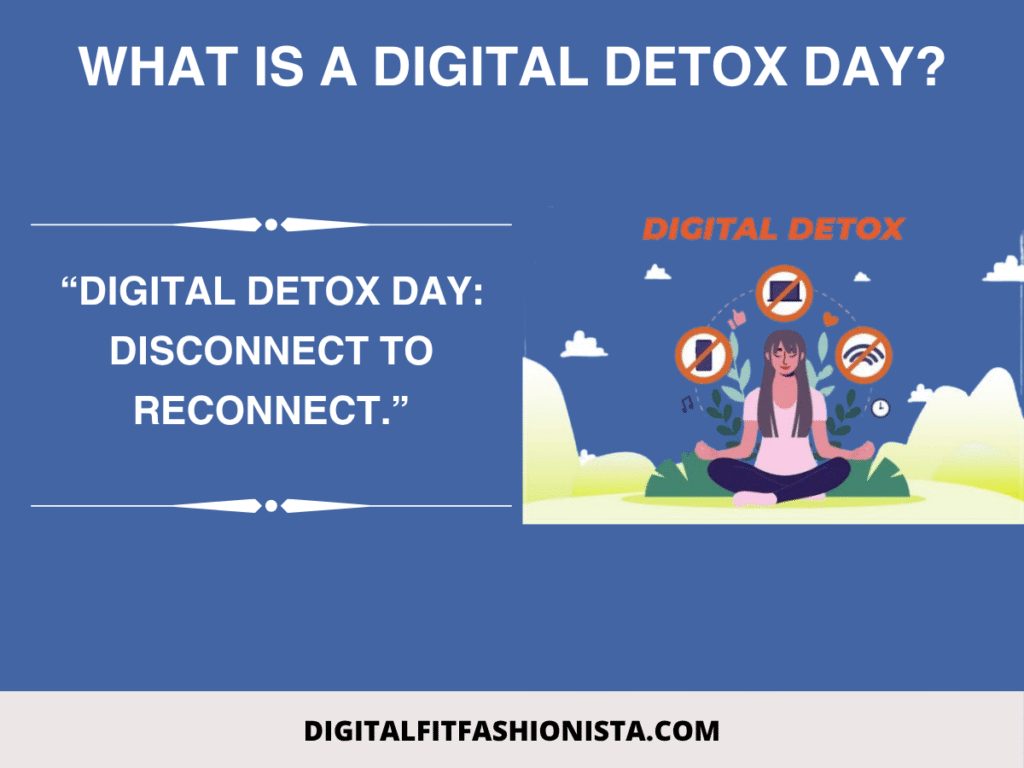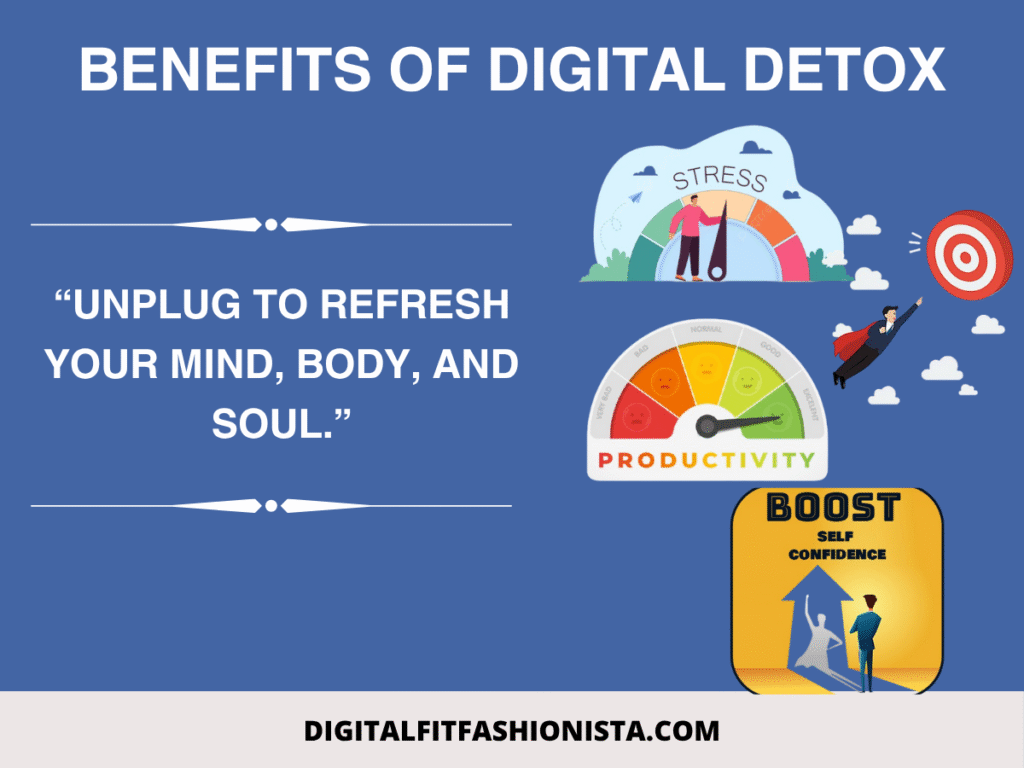What is a digital detox day? A digital detox day is a special day when you completely disconnect from screens and gadgets like smartphones, laptops, and social media to give your mind and body a break. Sounds simple, right?
But have you ever wondered why so many people are choosing this practice and how just one day without screens can change your mood, productivity, and even your sleep?
In today’s fast-paced world, where notifications never stop, a digital detox day can feel like a breath of fresh air.
Curious to know why it’s important, what benefits it brings, and how you can plan your detox day without stress?
Keep reading—you’ll discover everything you need to make it a refreshing and life-changing experience!
What is a digital detox day?

A digital detox day is a day dedicated to staying away from screens—phones, laptops, tablets, and even social media.
It’s about giving your mind and body a break from constant notifications and endless scrolling.
Instead of spending hours online, this day focuses on real-life activities like reading a book, going for a walk, or enjoying quality time with loved ones.
The goal is simple: reduce digital stress and bring back balance in your life.
What Is a Digital Detox?
A digital detox refers to a deliberate break from smartphones, social media, and other digital devices.
It doesn’t mean giving up technology forever; instead, it’s about reducing screen time and setting healthy boundaries with digital tools.
For example, you might choose to stay offline for a few hours each day, or plan a full day without your phone once a week. The goal is simple: restore balance, reduce stress, and improve your quality of life.
Why Do You Need a Digital Detox?
Modern life revolves around screens—phones, laptops, and TVs. A study shows that 25% of smartphone users aged 18–44 cannot remember the last time their phone wasn’t within arm’s reach. This dependency leads to several problems:

- Low self-esteem and constant comparison with others
- Anxiety, depression, and mental fatigue
- Sleep issues caused by late-night screen exposure
- Weight gain and unhealthy eating habits
- Poor time management and lack of focus
- Decreased physical activity, leading to posture problems
Experts explain that every scroll or swipe on your device releases dopamine, the same chemical involved in addictive behaviours like substance abuse. This makes it harder to put the phone down, creating a cycle of dependency.
Benefits of Digital Detox

Taking a break from digital devices offers countless benefits. Here are the most impactful ones:
1. Reduces Stress and Brings Mental Calm
Constant notifications and social media updates overwhelm your brain. Disconnecting helps you relax and focus on real-life experiences.
For example, spending an evening without your phone can significantly reduce anxiety levels.
2. Boosts Productivity and Focus
Endless scrolling eats up hours you could use for work or hobbies. A planned detox improves concentration, helping you complete important tasks faster.
Many professionals report better efficiency after reducing screen time.
3. Improves Self-Image and Confidence
Social media often creates unrealistic standards, leading to comparison and dissatisfaction.
A digital detox helps you disconnect from these triggers, improving your confidence and emotional well-being.
4. Promotes Physical Health
Prolonged screen time strains your eyes, causes headaches, and leads to neck and back pain. Taking breaks helps your body recover and prevents posture-related issues.
5. Enhances Sleep Quality
Using your phone before bed delays melatonin production, making it harder to sleep. By disconnecting at least an hour before bedtime, you’ll enjoy deeper and more refreshing sleep.
How to Start a Digital Detox
Starting a digital detox can feel challenging, but these practical steps make it easier:
1. Understand Your Habits
Track how often you use your phone and why. Do you check it out of boredom or necessity? Awareness is the first step toward control.
2. Set Time Limits
Schedule phone-free periods during the day. For example, avoid screens during meals or dedicate the first hour after waking up to offline activities.
3. Create Device-Free Zones
Keep gadgets out of your bedroom and dining area. This reduces distractions and improves relationships with family members.
4. Use Screen-Time Management Apps
Apps like Digital Wellbeing and Freedom monitor usage and block specific apps during certain hours, helping you stay disciplined.
5. Turn Off Notifications
Disable unnecessary alerts to minimise interruptions. The “Do Not Disturb” feature can be particularly useful during work or study time.
6. Disconnect Before Bed
Stop using your phone at least 60 minutes before sleep. Instead, try reading a book or meditating for better relaxation.
7. Replace Screen Time with Healthy Activities
Engage in offline hobbies like cooking, exercising, or gardening. These activities not only reduce your reliance on screens but also improve overall health.
8. Seek Professional Help if Needed
If you find it difficult to cut down screen time, consult a therapist. They can provide strategies to overcome tech addiction.
Extra Tips for a Successful Digital Detox
A digital detox works best when you complement the main steps with some practical lifestyle adjustments. Here are some powerful tips to make your detox more effective:
1. Plan Social Media Fasting Days
Choose one day every week to completely stay away from social media. This could be a Sunday or any day that suits you best.
During this time, log out from all your accounts or temporarily deactivate apps to avoid temptation.
Use this opportunity to reconnect with yourself and your loved ones. You can spend the day doing activities like cooking, exercising, or even catching up on a hobby like painting or writing.
A social media fast reduces the pressure of constant comparison and notifications, giving your mind a refreshing break.
2. Enjoy Nature and Outdoor Activities
One of the best ways to keep your mind off your phone is to go outdoors. Plan a walk in the park, a picnic, or even a weekend hike.
Being in nature not only lowers stress levels but also boosts mood and creativity. Leave your phone at home or keep it on aeroplane mode to avoid the urge to check it.
Breathing fresh air and soaking in natural surroundings can significantly reduce anxiety and improve mental clarity.
3. Start Small and Increase Gradually
Don’t try to cut out all screen time at once—it can feel overwhelming. Begin with small steps like staying offline for 30 minutes in the morning or during meals.
Once you’re comfortable, increase the duration to an hour or even half a day. Gradual changes are easier to stick to and help you build long-term habits.
For example, start by avoiding your phone during breakfast, then extend it to the first hour after waking up.
4. Inform Friends and Family About Your Detox
Let people in your circle know about your digital detox plan. This helps avoid misunderstandings and ensures they don’t expect instant responses from you.
You can even involve them in the process by planning group activities like board games, outdoor trips, or device-free dinners.
When your loved ones support your goal, you’re more likely to stay committed and enjoy real-world interactions.
5. Keep a Journal of Your Progress
Documenting your journey is an excellent way to stay motivated. Write down how much screen time you avoided, what activities you enjoyed, and how you felt throughout the day.
Over time, you’ll notice positive changes like better focus, improved sleep, and reduced stress.
A journal also helps you identify patterns—such as when you’re most tempted to check your phone—so you can address them effectively.
6. Replace Digital Habits with Offline Hobbies
Filling the gap left by reduced screen time is essential. Explore hobbies like reading books, gardening, cooking new recipes, or even learning a musical instrument.
Offline activities not only keep you busy but also boost your creativity and mental well-being.
For instance, instead of scrolling social media in the evening, try journaling your thoughts or doing a quick home workout.
7. Reward Yourself for Staying Consistent
Set small milestones for your digital detox—such as completing a day without social media or avoiding screens after 9 PM for a week—and reward yourself when you achieve them.
This could be something simple like a favourite snack, a new book, or a relaxing self-care activity. Rewards reinforce positive behaviour and make the process enjoyable.
8. Use Physical Alternatives for Digital Tools
Sometimes, we rely on our phones for simple things like checking the time, making a to-do list, or reading news.
Replace these with physical alternatives: use a wristwatch, keep a paper planner, or read a physical newspaper.
These small changes reduce the urge to pick up your phone unnecessarily and help you stay committed to your detox plan.
Conclusion
In today’s fast-paced world, digital detox is essential for mental peace, physical health, and a balanced lifestyle.
It reduces stress, improves productivity, and strengthens real-world connections. Whether you start with a few hours offline each day or commit to weekly no-screen days, the benefits will transform your life.
Remember, technology is a tool, not a trap. Take control, prioritise your well-being, and enjoy the freedom that comes from disconnecting.
FAQs
1. What happens during a digital detox?
During a digital detox, you intentionally reduce or completely avoid the use of smartphones, social media, and other electronic devices. This break helps lower stress, improve focus, and promote better mental and physical health. Many people use this time to engage in offline activities like reading, exercising, or spending quality time with family and friends.
2. Is a digital detox good or bad?
A digital detox is highly beneficial for both mental and physical well-being. It helps reduce anxiety, improves sleep quality, and boosts productivity by eliminating distractions. However, the key is balance—you don’t have to quit technology forever. Even short breaks from screens can bring positive changes without disrupting important work or communication.
3. How do you take a digital detox day?
To take a successful digital detox day:
Plan: Inform friends and colleagues so they know you’ll be offline.
Create device-free zones: Keep your phone away from your bedroom or dining area.
Engage in offline activities: Read a book, go for a walk, or try a hobby.
Turn off notifications: This reduces the temptation to check your phone.
- Is it possible to reverse skin ageing? - August 21, 2025
- How to regain motivation during burnout? - August 12, 2025
- What is a digital detox day? - July 31, 2025


